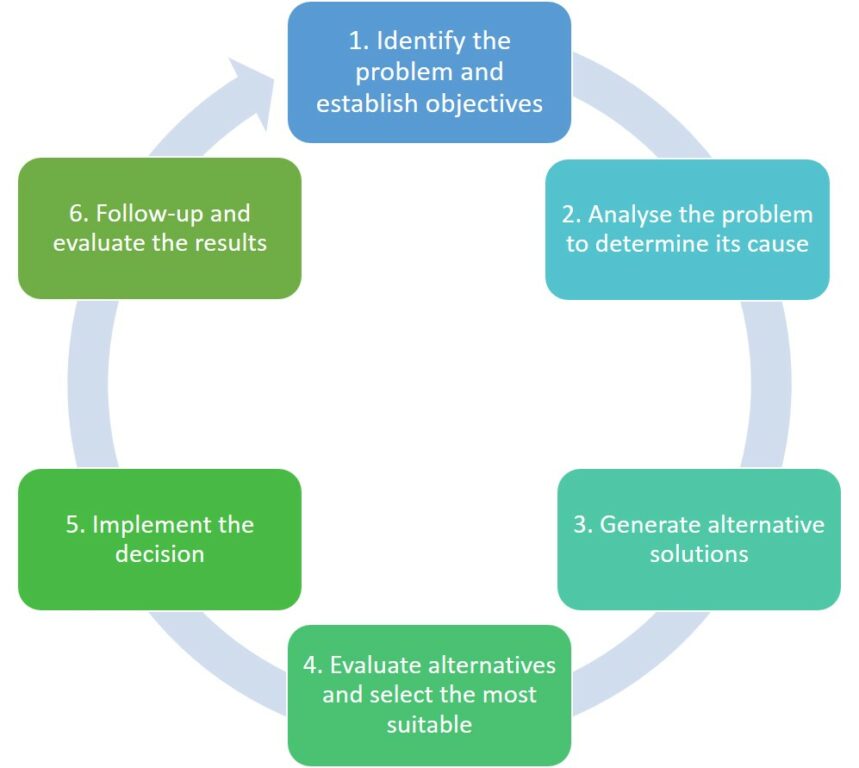Sometimes it takes the voice of an experienced mentor to help us accept and act on difficult truths.
Continue readingLearning from each other through mentoring
A local government leader and an HR expert gained fresh perspectives through mentoring.
Continue readingIdentifying potential leaders during tough times
While there’s plenty of challenges that arise amid a crisis, there are also culture-defining opportunities. One of them is an enhanced ability to identify leadership potential. Let’s explore some of the behaviours to look out for in your team members.
Continue readingClosing the student employability gap
Every student’s goal when completing higher education is to increase their employability. But the reality for many is that the highly competitive job market puts students at a disadvantage. Find out why this is the case and what can be done to close the employability gap.
Continue readingVirtual Development Day: Watch our recorded sessions
Click on the link below to enter your details and get access to the recorded sessions from our first ever IML ANZ Virtual Development Day. You will be redirected to the sessions upon submission.
Mentoring: Support and advice during these tough times
When we are all surrounded by so much uncertainty, it helps to find someone we can trust.
From a professional perspective, a mentor can be just that – someone who has our best interest at heart. Although a manager might seem the best placed to provide work-related advice, sometimes it helps to get a different view of things.
Mentoring provides a safe sounding board
As the University of Melbourne’s Mobile Learning Business Manager, Edwina Coller AFIML explains, “There are often areas that mentees don’t want to discuss with their manager because it’s about them personally and not relevant to their role.”
During these tough times, we are all inundated with things that have changed, that we aren’t sure of and things that cause us to be fearful. We may not be comfortable discussing those things with our manager.
Fresh perspectives during tough times
Surviving through difficult circumstances can take a toll on our ability to think and make decisions. That’s why Onno Van Es FIML, Manager HR Strategy and Engagement at Mackay Hospital and Health Service, makes sure his mentees are clear about how the mentoring process can benefit them.
“My style of mentoring is based around adult learning principles. It’s not a lecture style of learning, where I provide all the answers. Rather, I focus on the mentee taking ownership of their learning by being internally motivated and self-directed,” says Van Es.
Whether you are looking for new perspectives, want a sounding board you can trust or simply need to expand your social and professional connections, mentoring can help you.
Become a mentor or mentee now
IML ANZ Members enjoy complimentary access to the Member Exchange mentoring program.
Now is your chance to give and gain support from other managers and leaders during this extraordinary period. A new mentoring cohort starts in mid-May. To take part, register here before 24 April.
MEMBER EXCHANGE – Tools and resources to get ahead
In an opinion piece for the Sydney Morning Herald, Jim Bright, professor of career education and development at ACU, discussed how to get ahead in your career and leadership. Bright states, “If you want to get ahead, work with what is in front of you, not what you think should be in front of you. Great leaders are great improvisers in the sense that they make do… with whatever is at their disposal”.
Indeed, it can be so easy to blame others or external circumstances for your situation – but leaders are decisive and get on with it regardless of the situation. They take limitations and turn them into opportunities to innovate and collaborate.
That’s why having the right tools or resources at hand matters. Depending on the situation you face, there is a wealth of materials leaders can draw upon to help them tackle the challenges.
Constructive criticism
Bright also discussed the need to surround yourself with “people who care enough to be critical in a positive way”. If leaders only surround themselves with “yes” people, a toxic environment can result as colleagues and staff resent the narrow view and are frustrated with their own inability to make changes. The “yes” people can be reasonably safe, but only for so long. Good leaders need people they can trust, who keep them honest, question, critique and explore opportunities.
Soft skills
Effective leaders need to have a vision, but the vision is limited if it can’t be communicated effectively. Effective leaders are hard on themselves in a way that creates growth rather than destruction. Effective leaders are flexible and adaptable enough to seek solutions to challenges and strong enough to hold their vision and include others in their successes.
Analytics tools
As a leader, it’s very important to have a grounded assessment of your strengths and areas of challenge. There are many psychometric tools available and if used as a tool, rather than a prescription, are very effective to know what strengths you play to and where your areas of growth could be. The list below is just a sample of what’s available – all have similarities and it’s really a matter of personal preference, access and cost.
- Myers Briggs Type Indicator (MBTI) – personality tool
- DiSC – behavioural profiling tool
- Print – Unconscious Motivators tool
- Strengths Finder (Tom Rath)
- Life Styles Indicator (LSI) – underlying thoughts and motivations leading to behaviours
- Enneagram – personality tool
- Harrison Assessments – talent management tool
Books on leadership
There is a huge spectrum of leadership books on the market. The following list is a small introduction to get you thinking about different leadership elements and approaches.
- The 7 Habits of Highly Effective People, by Stephen R. Covey, continues to be a very powerful self-development tool for leaders, especially if you are new to leadership.
- The Truth about Trust (in Business), by Vanessa Hall, provides practical and anecdotal insights on how to increase results, retention and improve business relationships.
- The Five Literacies of Global Leadership by Richard David Hames focussing on authentic leadership in a changing, and frequently challenging time.
- Primal Leadership: Realising the Power of Emotional Intelligence by Daniel Goleman who builds on his Emotional Intelligence book and specifically looks at its application to leadership.
- The 5 Levels of Leadership: Proven Steps to Maximise Your Potential by John C. Maxwell explains how leadership doesn’t come from a title, but it’s about the ability to inspire and build a team that produces not only results but also future leaders.
- Start with Why: How Great Leaders Inspire Everyone to Take Action by Simon Sinek. Explores beyond what and how we do our roles and delves into the Why – because this is the thing that inspires us and those around us.
- Leading from the Emerging Future: From Ego-System to Eco-System Economies by Otto Scharmer and Katrin Kaufer who explore the need for shifting from an “ego-system” focussed on oneself to an eco-system which emphasises the well-being of the whole.
- Dialogue: The Art of Thinking Together by William Isaacs. This book, based on over ten years’ research, discusses the value within organisations to use language and listening successfully to build positive cultures.
- The Leader’s Digest: Timeless Principles for Team and Organization Success by Jim Clemmer is a series of insights and bite-sized briefings on the timeless principles of leading people.
- Clear Leadership: Sustaining Real Collaboration and Partnership at Work by Gervase R. Bushe who provides interesting and challenging insights into how to build organisational cultures without fear, creating a culture where healthy partnerships and collaboration are organised and sustained.
- Leadership Matters: 7 Skills of Very Successful Leaders by David Pich and Ann Messenger. IML ANZ’s Chief Executive, David Pich and Board Chair, Ann Messenger provide insights on leadership shaped by practice rather than theory – the ‘perspiration’ rather than the ‘inspiration’.
MEMBER EXCHANGE – Tips for perfecting prioritisation
In the hustle of the modern workplace, it’s very easy to spend a lot of time completing not much. That is, people put a lot of time and effort into completing the least important jobs, while the things that really matter are overlooked or not given the attention they deserve.
Sometimes this is because we prefer to work on things that interest us, or we do the easy quick tasks because it is so satisfying to look at a list of completed jobs. Frequently, however, it is because we have not properly identified and prioritised what we should be doing.
So, what are the demands on your time? What techniques do you currently use to manage your time effectively? What tools can you use to help schedule tasks? How can technology help you prioritise?
Below are some guidelines to get you thinking about how to effectively prioritise your tasks and manage your time:
The five Ds
Most peoples’ days are so busy that they find it impossible to do everything. It is essential to decide what you will deal with now, do later, delegate, do only if time permits, and what you won’t do at all. This can help you develop a work schedule and set priorities that concentrate on activities that will contribute directly to your overall job goals. It allows you to distinguish between what’s important and unimportant, what’s vital and superfluous.
In summary, the five Ds:
- Do it now
- Do it later
- Do it if time permits
- Delegate it
- Dump it
To-do list
A lot of people use a to-do list but how effective and methodical is yours? No matter how good your memory is you’re probably far too busy to remember everything you need to do. Lists are indispensable to keep you focused on what you need to accomplish to achieve your goals, no matter how hectic things get. They save you from the ‘tyranny of the urgent’ – attending to whatever floats across your field of vision, whatever seems the most urgent at the time, or whatever ‘makes the most noise’.
Here are some specific things that to-do lists can be useful for:
- To plan your day or week
- To establish priorities to remind you to do things
- To note down promises and commitments you’ve made so you don’t forget them
- To remind you to follow up on promises others have made, tasks you’ve delegated, and finish off part-completed work.
- To group like tasks together, and to do them together in blocks of time
The A-B-C priority shorthand
The A-B-C method can be an effective way to set priorities. Look at your tasks, identify the important ones, those that most directly contribute to achieving results in your key result areas. Assign them an ‘A’ priority. Matters that are both urgent and important are ‘A’ priorities too.
Which tasks contribute least and can wait if you don’t have enough time to do them? These are activities that don’t contribute directly to your key result areas and are not urgent. Assign them a ‘C’ priority. The rest are ‘B’ priorities.
Try to get through as much of your to-do list each day as you can, focusing on your ‘A’ priorities. That way, if you don’t get everything done, it will be the least important things that are left. Don’t ignore the ‘Bs’ and ‘Cs’ though because many of them will be urgent ‘As’ if you don’t get on with them.
Tame the telephone
If someone calls at a bad time, say so and arrange a time when it will be convenient for you both to talk.
To prevent lengthy calls, stand up. Your voice will take on a more urgent tone and encourage callers to be to the point.
Make several outgoing calls together and have a note of what you want to discuss.
Keep a note of what you want to speak to people about as well as a note of telephone messages you leave for others on your to-do list. Cross their names off when they return your call and follow up anyone who doesn’t get back to you.
Conquer emails
Where possible control your emails by turning off the audio alert that announces new mail and check for new mail only when it’s convenient to do so in blocks of time.
Remove your name from distribution lists that send information you seldom have time to read.
Scan emails for priority and subject titles and read only the most important; delete the unimportant ones. Pop the rest into folders to read or action. Keep culling and filing read and sent emails, so the size of your files doesn’t build up to unmanageable proportions.
Master time management tools
Effective time-management primarily depends on personal discipline and willpower; planning tools can help you win that daily battle with time.
We are working in a modern workplace, with modern productivity issues. That means we need to resolve these issues with modern tools and approaches to productivity. Your team might all use the electronic calendar to manage their meetings, but that is only half of their workload. Most may still be using paper tools to manage their priorities, meeting notes and project information. Lead by example here and fully embrace technology to centralise and organise all of your work.
Here are a few additional guidelines to get you thinking about how to make the best use of diaries and calendars:
- At the beginning of the year, enter important dates such as staff meetings, vacations, and conferences.
- Break activities into time blocks, with a beginning and an end. Time management problems are often caused by fuzzy end times.
- Don’t allow the entire day to be booked out. Leave some spare time to accommodate unexpected interruptions and thus reduce messy rescheduling or cancellations.
- Avoid scheduling yourself too tightly. The pressure to finish one task or meeting in time to begin another reduces your effectiveness.
- Allow time for rest, lunch and relaxation; error rates and stress increase with lack of rest.
- Block in time to complete important projects and schedule enough time to build up momentum.
- Ensure you can always carry your paper-based or electronic diary with you.
- Understand your unique energy cycle. When are you full of bounce and energy, a bit flat, or somewhere in between? Learn to use your peak energy periods for activities requiring careful thought and effort and avoid interruptions during this time.
MEMBER EXCHANGE – The problem-solving process
We all encounter problems daily. That’s why we all benefit from good problem-solving skills.
In the workplace problem solving is an important part of any job. The skill with which we solve problems has a direct impact on our professional effectiveness. So let’s consider what problems you have solved recently. How have you handled them?
Although we are not always conscious of our method, most of us follow similar steps to solve problems. It is useful to increase our consciousness of these steps and apply a variety of proven problem-solving techniques to ensure we find effective solutions. Using the following process can improve our effectiveness in solving problems:
The process of solving problems

Identify the problem and establish objectives
This step is the most important and often the most difficult. It can be easy to jump into solution mode and spend surplus time looking for answers rather than having clarity on what really is the problem. Try to state the problem in a single sentence and ensure not to confuse the symptoms, the causes and the problem.
To establish objectives, think about the result you want. Compare where you are now and where you would like to be and be clear in what you are setting out to achieve.
Analyse the problem to determine its cause
In this step, it’s important to gather facts, ideas and opinions of others that may help in your analysis and assess the information without prejudice, preconceived ideas, or emotion to effectively determine the problem’s cause.
A technique used to uncover the main cause of the problem is to ‘ask why’ five times. Here is a ‘why’ chain for high employee turnover:
Why is there high employee turnover?
Why were the wrong people hired?
Why aren’t recruitment and selection techniques applied?
Why am I not confident in them?
Why is more training required?
We can determine from this chain the likely causes of this problem are poor selection and poor induction.
Generate alternative solutions
A choice of options needs to be considered in problem-solving. To find the best option, you must consider several solutions, that way you’re less likely to overlook the best course of action. Work on eliminating the cause of the problem and not just covering up its symptoms. Use brainstorming, creative thinking and ask others what they think to get the ideas flowing.
Evaluate the alternatives and select the most suitable
Evaluate your alternative solutions by considering the advantages and disadvantages of each. Remember the best solution will normally be the one with the most advantages and the fewest disadvantages. Ensure the most suitable option best meet your objectives.
Implement the decision
Now is the time to plan carefully how to implement your decision. Use the “who, how, what, where, why and when” prompts to develop your plan. Consider what could go wrong and how you will monitor progress to ensure your decision is working. Also, consider how you will communicate your decision to those impacted.
Follow-up and evaluate results
Routine follow-up checks will ensure that you have solved the problem. Check the symptoms again – have they gone? Take corrective action where necessary.
In summary, to continue to grow your problem-solving skills and build your personal effectiveness keep these guidelines front of mind:
- Adopt a systematic approach
- Focus on important decisions
- Avoid making snap decisions
- Don’t become a victim of analysis paralysis
- Base your decision on facts
- Don’t be afraid of making the wrong decisions
- Learn from your mistakes
- Use your imagination
- Resist making decisions under stress
- Make your decision and then move on
MEMBER EXCHANGE – How to conduct effective meetings
One of the many disadvantages of becoming an ‘accidental manager’ is that most of the time they become managers largely due to technical abilities and less because of their people management skills. After all, it’s never easy to manage people, especially their former peers.
Although new people managers are keen and excited about new challenges there are some fundamental aspects of managing teams which they may have taken for granted. One such example is when they inherit a team meeting format. While this format may be highly effective, often it is heavily influenced and suited to the previous manager.
Being a new manager is the perfect opportunity to make your mark and running an inclusive and effective team meeting is an excellent place to start. Below are some key elements which the research indicates will create a dynamic and purposeful meeting culture.
Have a purpose
Why is the meeting being held? The answers to this question will inform the agenda, structure and style. It helps if the purpose is aligned to the team goals, even in a broad sense. A team meeting is also a perfect opportunity to achieve a lot of things and a chance to catch everyone up on what’s going on in the overall scheme of things – gives the team the big picture context and how this relates to the team.
Set an agenda
If you have a purpose, you need an agenda. This list of things you want to cover will determine how much time can be spent on each item. If an item on the agenda requires more time than is available, it needs to be prioritised, moved to the next meeting or given a meeting of its own. Regular meetings also help provide focus and momentum for the team.
Stay on time
Meetings need to start on time and finish on time. Avoid recapping for people who are late, as this indicates that lateness is OK. Update them after the meeting. Timeliness also relates to following the agenda and being purposeful.
Take minutes (distribute promptly)
Someone should be assigned to take minutes at every meeting (ideally someone different each time). The minutes provide a record of what was discussed and agreed. They help keep everyone in the team aligned and set tasks and time frames for action items.
Create a mindful environment
We don’t mean integrating meditation into your meetings. This simply means making sure everyone is aware and, in the moment, not distracted and wandering mentally. One effective way of doing this is to implement ‘no phone’ periods when discussing the most essential items on the agenda. By doing this you’ll ensure that every minute of the meeting counts toward achieving outcomes.
Paint the bigger picture
Always provide people with a fundamental understanding of where the business is going. Don’t just provide a cursory statement like, “Everything’s good”. Go into detail. The better informed your team, the better decisions they’ll make. Avoid the temptation to launch into long diatribes with too much information. Remember, it’s about getting the broader view.
Encourage participation
A simple way to do this is to have different team members lead the meeting. It’s important that this role is voluntary, so people are in their comfort zone or do so due to a desire to grow and develop in this area. Create a safe environment to encourage contribution. When team members are invited to share ideas, different perspectives emerge. Don’t be quick to shoot new ideas down and commend participants when they volunteer their thoughts.
Celebrate successes
Team meetings provide an excellent opportunity to acknowledge successes for the whole team and individual contributions. Team members are more likely to proactively contribute to tasks and roles if their contribution is valued and appreciated. It doesn’t always need to be a big deal, a simple thanks for specific rather than general contributions will usually do. The key is to be genuine and specific – that way it feels personal.
Make it fun
A simple way of building and maintaining rapport within the team is to have some fun together. Although team meetings need to be purposeful, having personality, a few laughs and celebrating successes all contribute to the effectiveness of a team meeting and connection between team members.
These suggestions and recommendations need to be adopted within the context of your work environment and how your teams and structures are organised. Don’t discount good ideas from team members around what would work well for your meetings. The key is to make the meetings relevant and give them your flavour – it’s a great way to establish your own management style.











